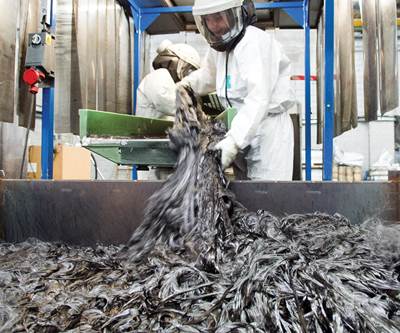Perhaps we’re getting closer to fiberglass recycling
Earlier this year I wrote an article on composites recycling and one of the things that struck me was how little fiberglass composite waste was being recycled.

This photo is taken from a YouTube video posted by Matpro Machinery (Glasgow, Scotland) showing how their equipment is used to recycle old wind turbine blades.
Earlier this year I wrote an article on composites recycling (here’s the link: https://www.compositesworld.com/articles/composites-recycling-gaining-traction ) and one of the things that struck me was how little fiberglass composite waste was being recycled. OK, I know you’re thinking, carbon is worth recycling and glass is not, because carbon has more value. But we’re coming to a point where composite parts, carbon and glass, have been deployed for several decades, and perhaps are nearing the end of their service lives — do we just throw these parts away? For example, how do you throw away a wind blade that’s 50m long? The disposal of spent blades is a growing problem that tends to be ignored by renewable energy advocates.
General Electric (Boston, MA, US) recently posted an article entitled “Comeback Kids: This Company Gives Old Wind Turbine Blades A Second Life” written by Amy Kover, on its GE Reports web site, a daily news, video and social media hub featuring timely, insightful articles. According to the article, repowering — or replacing existing technology with more advanced tech, such as newer blades — can increase an entire wind farm’s performance by up to 25 percent and extend its life by up to 20 years. But, says Kover, repowering also creates a new twist on the ages-old conundrum trailing progress: what to do with the obsolete technology. Crushing a blade yields about 15,000 pounds of fiberglass waste, and the process creates hazardous dust. Given their enormous length, sending them to a landfill whole is out of the question.
The article goes on to describe the efforts of Ronald Albrecht and Don Lilly of Global Fiberglass Solutions Inc. (Bothell, WA, US). Their Seattle-area-based company, which has been recycling fiberglass since 2008, has invented a way to transform the old blades into products like manhole covers, building panels and pallets. The process begins at the wind farm itself, where technicians from GFSI cut dismantle blades into more manageable 37-meter chunks. To minimize — if not eliminate — hazardous dust, GFSI uses wet wire blades that are thin and strong enough to slice each wind blade open as cleanly as a cantaloupe. Then the company sprays a light mist of water so that debris rains into a giant dustpan lying beneath the blade.
Next, GFSI loads the dismantled blades onto trucks and hauls them to nearby yards where the blades are shredded into raw fiberglass material. A single blade yields about 15-20 bags of this waste, weighing between 700 and 1,000 pounds each. GFSI will reuse 100 percent of each blade. Even the bolts that circle the blade’s end section go to a metal salvage site for recycling.
According to GFSI, it has developed a patented and proprietary process for recycling fiberglass, grinding it into recyclable feedstock that is mixed with other compounds to form a moldable material, that it has trademarked Ecopolycrete, and making new products, like manhole covers, which are made of the reclaimed fiberglass mixed with rock and filler, says Kover’s article. Here’s a link to the GFSI web site: https://www.global-fiberglass.com/.
GE, which has been working with GFSI, can then buy back its old wind blades as new products. GFSI has recycled a total 564 blades for GE in less than a year, and based on current plans, GFSI estimates that GE could reuse 50 million pounds of fiberglass waste in the next couple of years.
Here’s the link to Kover’s complete article on GE Reports: https://www.ge.com/reports/comeback-kids-company-gives-old-wind-turbine-blades-second-life/. This is just one of several ongoing projects related to recycling of fiberglass waste, primarily from wind blades, and it’s a topic that I’ll continue to keep tabs on. If you know of a glass recycling project, please let me know.
Related Content
JEC World 2023 highlights: Recyclable resins, renewable energy solutions, award-winning automotive
CW technical editor Hannah Mason recaps some of the technology on display at JEC World, including natural, bio-based or recyclable materials solutions, innovative automotive and renewable energy components and more.
Read MoreHexagon Purus opens new U.S. facility to manufacture composite hydrogen tanks
CW attends the opening of Westminster, Maryland, site and shares the company’s history, vision and leading role in H2 storage systems.
Read MoreHonda begins production of 2025 CR-V e:FCEV with Type 4 hydrogen tanks in U.S.
Model includes new technologies produced at Performance Manufacturing Center (PMC) in Marysville, Ohio, which is part of Honda hydrogen business strategy that includes Class 8 trucks.
Read MoreMingYang reveals 18-MW offshore wind turbine model with 140-meter-long blades
The Chinese wind turbine manufacturer surpasses its 16-MW platform, optimizes wind farm construction costs for 1-GW wind farms.
Read MoreRead Next
Composites recycling: Gaining traction
Recycling of carbon fiber, glass fiber and — at last — resins, is growing as new players enter the space.
Read MorePlant tour: Daher Shap’in TechCenter and composites production plant, Saint-Aignan-de-Grandlieu, France
Co-located R&D and production advance OOA thermosets, thermoplastics, welding, recycling and digital technologies for faster processing and certification of lighter, more sustainable composites.
Read MoreVIDEO: High-volume processing for fiberglass components
Cannon Ergos, a company specializing in high-ton presses and equipment for composites fabrication and plastics processing, displayed automotive and industrial components at CAMX 2024.
Read More













.jpg;maxWidth=300;quality=90)








